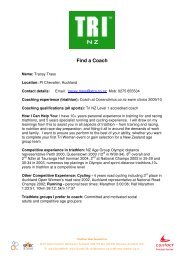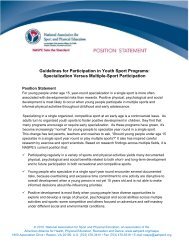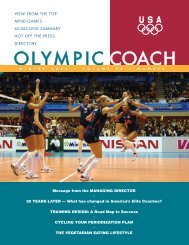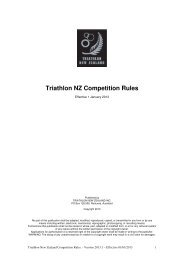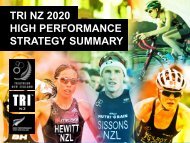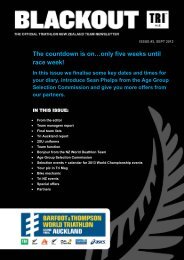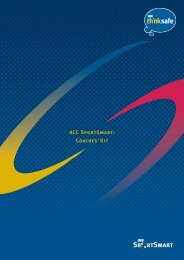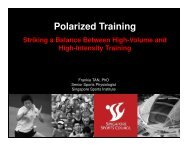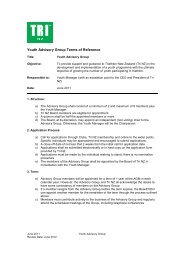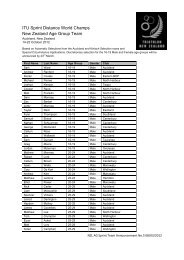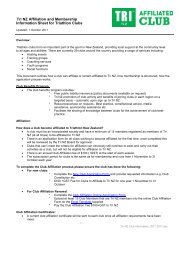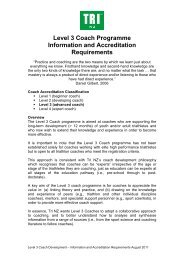The Science of Cycling - IngentaConnect
The Science of Cycling - IngentaConnect
The Science of Cycling - IngentaConnect
Create successful ePaper yourself
Turn your PDF publications into a flip-book with our unique Google optimized e-Paper software.
286 Faria et al.<br />
information that is useful to athletes, coaches and exercise scientists in the<br />
prescription <strong>of</strong> training regimens, adoption <strong>of</strong> exercise protocols and creation <strong>of</strong><br />
research designs.<br />
Here for the first time, we present rationale to dispute prevailing myths linked<br />
to erroneous concepts and terminology surrounding the sport <strong>of</strong> cycling. In some<br />
studies, a review <strong>of</strong> the cycling literature revealed incomplete characterisation <strong>of</strong><br />
athletic performance, lack <strong>of</strong> appropriate controls and small subject numbers,<br />
thereby complicating the understanding <strong>of</strong> the cycling research. Moreover, a<br />
mixture <strong>of</strong> cycling testing equipment coupled with a multitude <strong>of</strong> exercise<br />
protocols stresses the reliability and validity <strong>of</strong> the findings.<br />
Our scrutiny <strong>of</strong> the literature revealed key cycling performance-determining<br />
variables and their training-induced metabolic responses. <strong>The</strong> review <strong>of</strong> training<br />
strategies provides guidelines that will assist in the design <strong>of</strong> aerobic and anaerobic<br />
training protocols. Paradoxically, while maximal oxygen uptake ( ˙VO2max) is<br />
generally not considered a valid indicator <strong>of</strong> cycling performance when it is<br />
coupled with other markers <strong>of</strong> exercise performance (e.g. blood lactate, power<br />
output, metabolic thresholds and efficiency/economy), it is found to gain predictive<br />
credibility.<br />
<strong>The</strong> positive facets <strong>of</strong> lactate metabolism dispel the ‘lactic acid myth’. Lactate<br />
is shown to lower hydrogen ion concentrations rather than raise them, thereby<br />
retarding acidosis. Every aspect <strong>of</strong> lactate production is shown to be advantageous<br />
to cycling performance. To minimise the effects <strong>of</strong> muscle fatigue, the efficacy <strong>of</strong><br />
employing a combination <strong>of</strong> different high cycling cadences is evident. <strong>The</strong><br />
subconscious fatigue avoidance mechanism ‘teleoanticipation’ system serves to<br />
set the tolerable upper limits <strong>of</strong> competitive effort in order to assure the athlete<br />
completion <strong>of</strong> the physical challenge.<br />
Physiological markers found to be predictive <strong>of</strong> cycling performance include:<br />
(i) power output at the lactate threshold (LT2); (ii) peak power output (Wpeak)<br />
indicating a power/weight ratio <strong>of</strong> ≥5.5 W/kg; (iii) the percentage <strong>of</strong> type I fibres<br />
in the vastus lateralis; (iv) maximal lactate steady-state, representing the highest<br />
exercise intensity at which blood lactate concentration remains stable; (v) Wpeak<br />
at LT2; and (vi) Wpeak during a maximal cycling test. Furthermore, the unique<br />
breathing pattern, characterised by a lack <strong>of</strong> tachypnoeic shift, found in pr<strong>of</strong>essional<br />
cyclists may enhance the efficiency and metabolic cost <strong>of</strong> breathing. <strong>The</strong><br />
training impulse is useful to characterise exercise intensity and load during<br />
training and competition. It serves to enable the cyclist or coach to evaluate the<br />
effects <strong>of</strong> training strategies and may well serve to predict the cyclist’s performance.<br />
Findings indicate that peripheral adaptations in working muscles play a more<br />
important role for enhanced submaximal cycling capacity than central adaptations.<br />
Clearly, relatively brief but intense sprint training can enhance both glycolytic<br />
and oxidative enzyme activity, maximum short-term power output and<br />
˙VO2max. To that end, it is suggested to replace ~15% <strong>of</strong> normal training with one<br />
<strong>of</strong> the interval exercise protocols. Tapering, through reduction in duration <strong>of</strong><br />
training sessions or the frequency <strong>of</strong> sessions per week while maintaining intensity,<br />
is extremely effective for improvement <strong>of</strong> cycling time-trial performance.<br />
© 2005 Adis Data Information BV. All rights reserved. Sports Med 2005; 35 (4)



